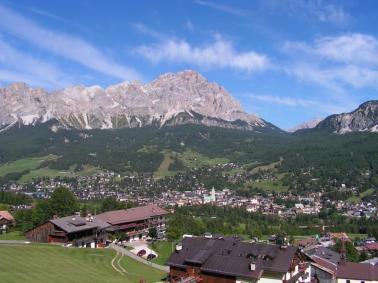Valle d'Ampezzo / Val de Anpezo
The valley of the Queen of the Dolomites: Cortina d'Ampezzo

Anpezzo is the ladin name of a Venetian valley and more precisely of the province of Belluno, geographically part of Ladinia, but also of Cadore. Ampezzo Valley, also known as the Conca Ampezzana, is, as a matter of fact, a wide and open dolomitic hollow. The layer that embraces the villages of Ampezzo is the result of the ancient glacier of the Quaternary period, that for thousands of centuries has used the Ampezzo Valley as a final basin. The Valley is located among Cadore, Pusteria Valley and Val Badia; the latter is linked through the Falzarego Pass and the Valparola Pass, places of atrocious episodes of the Great War.
The villages of Ampezzo are surrounded by the Dolomites of Ampezzo, part of which are under the protection of the Natural Park Dolomiti d'Ampezzo. The massifs of Sorapis, Croda da Lago, Nuvolau, Tofane, Pomagagnon, 5 Towers and Cristal are just few of the well-known names of the territory of Ampezzo, many of which step into the region of the Dolomites declared part of the World Natural Heritage by UNESCO.
The local population speaks Ladin as its mother tongue, with some Italian-speaking minorities. The Queen of the Dolomites, Cortina d'Ampezzo, is part of one of the eighteen municipalities of the Ladinia region and circumscribes the ladin area of the hollow of Ampezzo. Touristic resort of international relevance, Cortina d'Ampezzo has strongly developed with the organization of the winter Olympic Games in 1956, the first being broadcast by TV. The Olympics have irremediably transformed the ladin valley shifting the center of gravity of the economy strongly to mass tourism. Unlike the other villages of Ladinia, Cortina d'Ampezzo presents features of a mountain town. It is the only Italian place being part of the Best of the Alps; it hosts important sport infrastructures, relevant sport events, shops, boutiques, clubs and services for every taste, but still preserves ancient arts and tastes of the ladin culture.
It is to be said that Cortina is a paradise for winter sports, with marvellous slops and infrastructures, but also the summer offer is remarkable. The trampoline Italia, the Olympic slope Bob, the tennis stadium, the olympic ice-rink are just few of the sport facilities located in Cortina. During the cold season well three districts (Faloria – Cristallo – Mietres, Tofane and Lagazuoi 5 Towers) allow the skiing and snowboarding- lovers to have fun in a unique and extraordinary variety of slopes.
The natural sights of Cortina have led personalities of the importance of Hemingway and Montale to discover Cortina d'Ampezzo as one of the most beautiful places in the world.
Ampezzo has a relevant history which dates back into the past, like the rest of the Dolomitic valleys, with the invasion of the Roman empire; the first evidence of the existence of a stable settlement in the valley of Ampezzo, is dated in the year 1156 according to a notary deed. During the numerous European wars, the so called Conca Ampezzana, was sought after among many countries. During the last century the villages of the valley have been the scenario of war conflicts between Austria-Hungary and Italy. The fortress Tre Sassi on the Valparola Pass represents one of the many evidences of the fights, nowadays it hosts the Museum of the Great War. Also, at Valparola Pass you can find kilometres of tunnels and trenches of World War I, in a very interesting open-air museum. At Pocol, in direction of Falzarego Pass, it is situated a military shrine that hosts a thousand fallens' spoil.
Many are the religious buildings worth a visit, starting from St. Phillip and Jacob's Cathedral in Cortina d'Ampezzo city-centre, to the smaller churches of Virgin Mary of Defence and the one of St. Anton from Padua, to the ancient chapel consecrated to San Francesco. Among the museum located in Cortina you should remember the Museum of modern Art “Mario Rimoldi”, the paleontologic Museum “Rinaldo Zardini” and the ethnographic museum “Regole d'Ampezzo”, where there are exhibited the everyday- rural life objects of the past. The planetarium Nicolò Cusano and the astronomic observatory on the Druscé hill, allow a space exploration and its secrets.
Certainly you cannot say that the Ampezzo Valley is one of the quietest and most silent places in the Dolomites, but those who are looking for a fair mix of nature, sport and services in a touristic resort of big occasions, they will find in Cortina d'Ampezzo the place of their dreams with deluxe restaurants, wellness centres and an important nightlife.


Comments:
You may also be interested for:
For your stay Ladinia recommends:
Alcialc
Frapes
Haflingerhof
Fordi
Ciasa Ploner